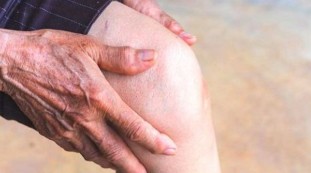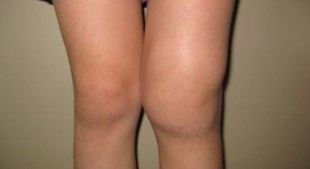Osteoarthritis of the knee joint (gonarthrosis) is a disease characterized by degenerative-degenerative changes in cartilage, menisci, and then the bones which form the knee joint yet. The disease takes a leading Position among the pathologies of the musculoskeletal system.

The causes of osteoarthritis of the knee
Osteoarthritis of the knee is polyetiological disease, that is, in this state, if the development of the pathological changes in several causal factors. In this case, one speaks of primary (idiopathic) osteoarthritis. In the case of secondary osteoarthritis of the knee is an accurate factor caused the disease.
Among the most important reasons of osteoarthritis:
- Knee injury;
- surgical interventions in the area of the knee;
- the increased physical stress;
- overweight, obesity;
- congenital pathology of the lower extremities;
- Syndrome of systemic connective tissue dysplasia;
- Metabolic disorders;
- General diseases (Diabetes mellitus, rheumatoid Arthritis, acromegaly).
Important!
The impact of traumatic agent is the primary cause of osteoarthritis in young age. Injuries of the knee, which belong to a osteoarthritis, sprains, fractures or damage to the menisci.
The basis for the development of the pathological changes in the need for the mobilisation of the joint after an injury, this contributes to a deterioration of the blood circulation in periarticular tissues, that leads, together with the existing mechanical damage sustained healing and the development of symptoms of osteoarthritis is.
The increased physical strain is evident not only in intensive employment by physical exercises, but also in the presence of obesity. Overweight and Training, not age, and physical Fitness of the individual, lead to the formation of micro-fractures in the cartilage or menisci, that was the first link in the process of the formation of osteoarthritis of the knee.
Congenital pathology of the lower extremities, leads to a shortening of the extremities, dysplasia, as well as valgus or Varus deformity of the feet, to the development of osteoarthritis due to the uneven weight distribution of the people. In consequence, deleted, cartilage hotbed of aseptic inflammation formed with the emergence of the characteristic clinical symptoms of osteoarthritis.
Syndrome of systemic connective tissue dysplasia characterized by a Hyper-mobility insufficiency and ligamentous apparatus. What is in the joint, the Amplitude of the movements increases, until the pathological. Such instability surfaces quickly leads to the emergence of micro-traumas of the menisci and cartilage of the joint.
Metabolic disorders and the effect of the presence of total somatic pathology, that the development of osteoarthritis due to disturbances of the microcirculation in the knee joint, a deterioration in the supply of the cartilage and the menisci, the deterioration of the composition of the synovial fluid.
Classification
Code according to ICD-10 – M17. Depending on the etiological factors, leading to the formation of osteoarthritis, there are the following categories:
- M17.0 – primary osteoarthritis of the knee right;
- M17.1 – a different primary osteoarthritis of the knee;
- M17.2 – post-traumatic osteoarthritis, right;
- M17.3 – other post-traumatic gonarthrosis;
- M17.4 – other secondary gonarthrosis, bilateral;
- M17.5 other secondary gonarthrosis;
- M17.9 – osteoarthritis of the knee is not updated.

There are the following types of osteoarthritis of the knee:
- involutional – is caused by age-related changes of the organism, disturbance of metabolic processes, wear of the articular surfaces of the bone use;
- inherited dysplastic contains associated with congenital malformations of the lower extremities;
- post-traumatic;
- metabolic – occurs in the General diseases, with metabolic disorders (gout, chondro calcinosis);
- dishormonal shows the hormonal imbalance in the body in Diabetes, menopause, disorders of the thyroid gland;
- post-inflammatory – occurs after infectious and inflammatory diseases of the knee joint;
- static – displays the excessive physical stress, the wrong distribution of the weight, adiposity;
- ischemic – associated with the violation of the blood supply to the Patella area.
Pathogenesis
The disease develops gradually. First, the changes appear in Podhradie – layer micro-cracks. The formation of micro-cracks due to the constant work of the knee joint, one of the functions of the damping of shocks is when you go. And if the etiological factors of stress on the king's meadow increases even more, and the processes of destruction begin to exceed the tissue, the processes of the restoration of cartilage, which may lead to cracks.
Then, in the cracks of joint penetrating fluid, and cysts are formed, the a tendency to enlargement and fusion. Large cysts begin to compress the blood vessels, cartilage, nourishes, what fabric to a lack of oxygen to cartilage. Violated the metabolic processes deteriorate in the synthesis of collagen, necessary for restoration of the cartilage. Given the poor recovery of the cartilage, there is a gradual thinning leads to disruption of the function of the joint, the clinical signs of the disease.
On the note!
To form with the progression of osteophytes start – bony growths. Osteophytes are mainly found at the edges of the articular surfaces, the use of bone. Their presence provokes pronounced inflammatory reaction in the joint, pain, deformity of the joint, significant limitation of mobility.
In the development of the inflammatory process, swelling of the tissue, which is disturbed to an increased pressure in the joint, the deterioration of the composition of the synovial fluid, nutrition of the cartilage occurs.
Clinical Symptoms.
In the course of the disease in different degrees of osteoarthritis, which is the process of Progression of the pathological changes and degree of clinical symptoms.distinguish
Symptoms of osteoarthritis of the knee joint can be divided into the stage:
- The first Phase of the disease is characterized by the appearance of pain in the area of king's meadow, especially after intense physical activity or a long stay on the legs. Less favorable to the static load, i.e. weight lifting. Pain in the joint itself is after the holiday. In addition to pain can crackle appear, or click in the joint, indicating that the violation of the congruence of the articular surfaces of the bone benefits that form the joint, and the occurrence of micro-cracks in the cartilage tissue. No strong clinical evidence leads to the fact that most patients do not seek treatment in the first Phase, that leads to late diagnosis.
- The progression of the disease leads to a pronounced pain syndrome – pain does not occur even after low-stress, alone. Stiffness appears in the morning in the joints, takes about 30 minutes, but when you attach an inflammation, then the bias can take up to 1 hour. Because of the severe pain the person starts the leg to conserve, reduces the Amplitude of the movements, lameness appears. Due to the swelling of the tissue in the king's meadow increases in volume. Radio appear logical signs of osteoarthritis of the knee.
- The formation of osteophytes characterized by the development of 3 stages of the disease, in the case of strongly expressed pain, even at rest, poorly jugulate drugs. Movement is not deformed virtually absent, the joint. Perhaps king's meadow in a certain Position, as well as dislocations or subluxations jamming.

Diagnostic Studies
Diagnosis of osteoarthritis consists of several components:
- The complaints of the patient.
- History of the development of the disease.
- History of the life of the patient.
- Laboratory and instrumental methods.
On the basis of complaints of the patient, as well as the history of life and of the disease, the doctor preliminary diagnosis. But for the implementation of the differential diagnosis with other diseases, and the establishment of an accurate diagnosis, conducting laboratory and instrumental methods requires.
Include instrumented methods of investigation of the knee joint:
- Radiography;
- Arthroscopy;
- Computed tomography;
- Ultrasound examination;
- Magnetic Resonance Imaging.
Important!
The most important means for the diagnosis of osteoarthritis the radiographic examination. An x-ray of the knee joint in two projections, a complete picture of the existing changes. It is important to note that in the initial stage of osteoarthritis in the photo are not identified.
On the basis of the detected radiological signs radio-based logical classification of osteoarthritis of the knee:
- 1 degree – a small joint gap;
- 2 degrees – a small joint gap, the advantage of the presence of bone-seal;
- 3 degree – severe joint space narrowing, presence of osteophytes, the first signs of a bony deformity;
- 4 degrees – pronounced joint space narrowing, until its complete absence, numerous osteophytes, destruction of bone tissue, deformity of the joint.
The other methods of investigation of the knee joint in addition to the primary x-ray examination. And as an additional diagnosis in case of difficulties in the diagnosis.
Each of the methods of diagnosis has its indications, contraindications and other expenses, therefore, should necessarily be a specialist assigned when necessary.
As for the treatment of osteoarthritis of the knee joint
The treatment of osteoarthritis of the knee joint, you need to start, when the first clinical symptoms of the disease. Modern treatment of osteoarthritis of the knee aims to restore the function of the joint and improving the quality of life of patients and is as follows:
- a termination or reduction of pain;
- Treatment of inflammation;
- the restoration of the structure of the cartilage;
- Increase in the Amplitude of movements;
- Improvement of the microcirculation in the periarticular tissues.

On the note! It is important to note, that in the different phases of the different possibilities of treatment. If you start in time to fight the disease, then you can not only pain, but also to repair the knee joint in osteoarthritis, but also prevent the occurrence of complications.
The applied drug therapy helps to reduce pain and the inflammatory response, this is achieved by the application of non-steroidal anti-inflammatory drugs. For the recovery of the cartilage chondro protector appointed. The scheme of treatment is ordered and controlled by the doctor.
In addition to medical treatment, physiotherapy, ointments, gymnastics, Massage or intra-articular injection of drugs assigned.
Treatment of osteoarthritis of the knee
In this case, the ingestion of gelatin, which can be taken orally or a a compress can. Traditional medicine should not be administered as monotherapy, but a part of the complex therapeutic measures. Before such a treatment at home, you should use the recommendations and reviews.
I can cure the osteoarthritis to
In the case of counterfeiters or delayed treatment, the consequences of the progression of the disease not to wait. Osteoarthritis of the knee is dangerous, because it is not the right treatment can stop the process completely, but only the brakes, but it allows a Person to stay a long time.
If the disease was more severe stage is a conservative treatment is ineffective. In the case of the 3-stage surgical treatment, according to a long-term Rehabilitation.






























